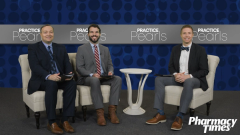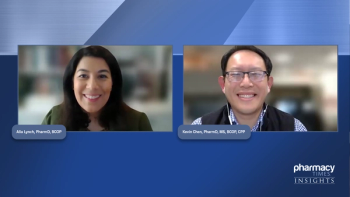
Utilizing Three-Drug Regimen in MM Treatment
Experts highlight the use of 3- and 4-drug regimens for managing relapsed refractory multiple myeloma.
Ryan Haumschild, PharmD, MS, MBA: Dr Hinojosa, I know pharmacists are involved in recognizing when an alternative therapy might be needed, either through counseling or patient follow-up. As part of the multidisciplinary team, when do you start to recognize and suggest a therapeutic update or recommend an alternative therapy? What patient-specific factors are you looking at in addition to what Dr Anderson mentioned?
Gabe Hinojosa, PharmD, BCOP: My favorite part of the job as a pharmacist is to finally get in that room and meet the patient, go in, do my counseling, get to know the patient [and] their family members as well, and discuss the logistics of what the course of treatment is going to look like. As Dr Anderson said, not looking at just cycle 1 but looking at the future down the road. What do the next 3 months, 6 months, and 1 year look like if we stay the course and things are going well on this therapy? So that’s my time to shine, to get in and build those connections with the patient. Often, that’s when things start to come up that may give me pause or give me an opportunity to make suggestions to the team [that] maybe we should consider a different therapy. Any time the patient is having these conversations with their provider, it can be a bit daunting, and they’re taking in as much information as they can. But sometimes we block out; we don’t hear everything exactly the way we thought we did. And when the pharmacist comes into the room to talk about the logistics of this therapy, they maybe didn’t realize [it] entailed twice-weekly visits for the next several weeks or weekly visits for the next 2 months. And they’re like, “Hold on, I don’t have a caregiver to bring me back for this injection every week for the next 8 weeks. What are some alternatives?” Those are times when the pharmacist can intervene, explain the scheduling [and] logistics, and give a realistic picture to the patient and remind them again of all the things their provider and team had explained previously.
Ryan Haumschild, PharmD, MS, MBA: I’ve heard both of you, Dr Hinojosa and Dr Anderson, comment on the value of proteasome inhibitors within the treatment landscape. So my question is, how are you seeing proteasome inhibitors being utilized, maybe by patient type, by standard risk, by high risk, and by those [experiencing relapse]?
Gabe Hinojosa, PharmD, BCOP: Proteasome inhibitors are one of the main backbones of myeloma therapy. In general, our use of proteasome inhibitors for patients [experiencing] standard-risk [disease], high-risk [disease], and relapse is going to be somewhat similar. Using them is the easiest way to summarize it. But we do see some unique differences, specifically in our patients [with] standard-risk [disease]. Many times, they’re able to get through their induction therapy. And as they’re progressing into their maintenance regimen, that proteasome inhibitor would often stop, whereas our patients [with] high-risk [disease] may be a patient population [for which] we consider continuing that proteasome inhibitor throughout their maintenance therapy. So it’s more of a long-term commitment and certainly something to talk to the patient about and make sure they’re aware that we may have this subcutaneous or intravenous therapy that would continue.
Ryan Haumschild, PharmD, MS, MBA: Dr Anderson, as we start to see the changing landscape in multiple myeloma [MM], we’ve seen a huge push for 3-drug regimens, and proteasome inhibitors are part of that. We know what it’s involved in [them]: the combination of many synergistic mechanisms of action that are different yet work together in combination to provide great benefits to the patient. In your experience, what’s driving toward this 3-drug regimen? And how do you see it emerging in the future?
Larry Anderson, MD, PhD, FACP: These days, it’s standard to use a 3-drug regimen, whether it’s front line or second line or third line. There’ve been multiple randomized studies comparing 3-drug regimens to 2-drug regimens that show not only longer remissions but, in many cases, improved overall survival. And these 3-drug regimens often include a proteasome inhibitor, often include a CD38 antibody, but it’s pretty mainstay to include 3 drugs at least because of the improved outcomes that we’ve seen.
Ryan Haumschild, PharmD, MS, MBA: We talk about 3 drugs at least, and I know you’re probably hinting…that we’re even looking at quadruplet therapy in the future. In your experience, what about some of the regimens with proteasome-containing regimens? With a 3-drug regimen, what is the impact on aggressive relapsed refractory [RR] MM vs indolent [MM], and how do you see 4-drug regimens starting to [affect] the future of care?
Larry Anderson, MD, PhD, FACP: In patients [with] aggressive or high-risk [disease who] are [experiencing relapse], we typically see best results with a proteasome inhibitor combination that works with those patients [with] high-risk [disease] with chromosomes [indicating] high-risk [disease]. So we’ll typically involve a proteasome inhibitor in those patients. And it depends on the aggressiveness of their relapse and what their prior treatment responses were. Up front, we’re more likely to use a 4-drug combination, and so it makes sense that at relapse, especially if they’re having aggressive disease relapse, [to] consider a 4-drug regimen as well.
Transcript edited for clarity.
Newsletter
Stay informed on drug updates, treatment guidelines, and pharmacy practice trends—subscribe to Pharmacy Times for weekly clinical insights.












































































































































































































